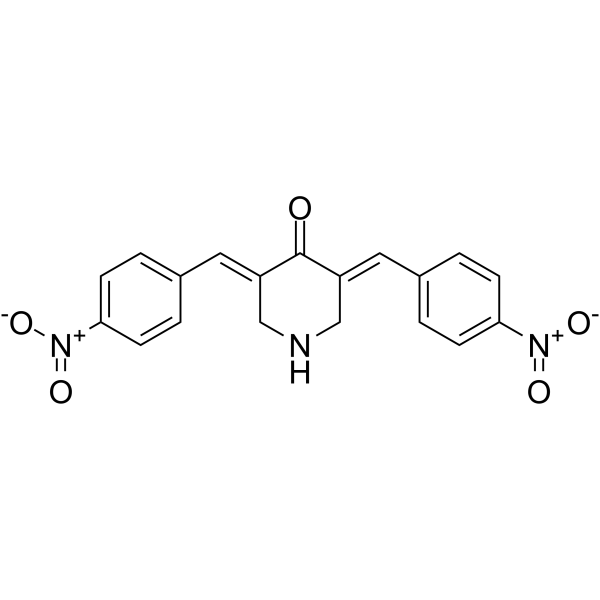| Cas No.: | 919091-63-7 |
| Chemical Name: | RA-9 |
| Synonyms: | 4-Piperidinone, 3,5-bis[(4-nitrophenyl)methylene]-, (3E,3E)-;(3E,5E)-3,5-Bis[(4-Nitrophenyl)methylene]-4-piperidinone;4-Piperidinone, 3,5-bis[(4-nitrophenyl)methylene]-, (3E,5E)-;RA-9 UPS inhibitor;RA-9;(3E,5E)-3,5-Bis[(4-nitrophenyl)methylene]-4-piperidinone (ACI) |
| SMILES: | C(/C1C=CC([N+](=O)[O-])=CC=1)=C1/CNC/C(=C\C2C=CC([N+](=O)[O-])=CC=2)/C/1=O |
| Formula: | C19H15N3O5 |
| M.Wt: | 365.339504480362 |
| Purity: | >98% |
| Sotrage: | 2 years -20°C Powder, 2 weeks 4°C in DMSO, 6 months -80°C in DMSO |
| Publication: | [1]. Coughlin K, et al. Small-molecule RA-9 inhibits proteasome-associated DUBs and ovarian cancer in vitro and in vivo via exacerbating unfolded protein responses. Clin Cancer Res. 2014;20(12):3174-3186. |
| Description: | RA-9 is a potent and selective proteasome-associated deubiquitinating enzymes (DUBs) inhibitor with favorable toxicity profile and anticancer activity. RA-9 blocks ubiquitin-dependent protein degradation without impacting 20S proteasome proteolytic activity. RA-9 selectively induces onset of apoptosis in ovarian cancer cell lines and primary cultures derived from donors. RA-9 induces endoplasmic reticulum (ER)-stress responses in ovarian cancer cells[1]. |
| In Vivo: | RA-9 (5 mg/kg; i.p; one-day on, two-days off) inhibits human ovarian cancer cell growth in vivo and prolongs survival in a mouse model for ovarian cancer[1]. Animal Model: Six-week-old female immunodeficient (NCr nu/nu) mice[1] Dosage: 5 mg/kg Administration: I.p; one-day on, two-days off Result: Significant reduction in tumor burden at day 12. |
| In Vitro: | RA-9 (10-30 μM; 48 hours) inhibits growth of ovarian cancer cell lines and primary cultures[1]. RA-9 (1.25-5 μM; 18 hours) causes cell cycle arrest and caspase-mediated apoptosis in ovarian cancer cells[1]. RA-9 (5 μM; 0-24 hours) induces ER-stress responses in ovarian cancer cells[1]. RA-9 (5 μM; over 24 hours) treatment results with time-dependent accumulation of the cleaved formed of PARP noticeable as early as 8 hours[1]. Cell Viability Assay[1] Cell Line: Cisplatin-sensitive ovarian cancer cell lines TOV-21G and ES-2, Cisplatin-resistant ovarian cancer cell lines HEY and OVCAR-3, primary ovarian cancer cells Concentration: 10, 20, 30 μM Incubation Time: 48 hours Result: Compromised the viability of ovarian cancer cells in a dose-dependent fashion. Cell Cycle Analysis[1] Cell Line: ES-2 cells Concentration: 1.25, 5 μM Incubation Time: 18 hours Result: Resulted in a dose-dependent increase in the fraction of ES-2 cells in the G2-M cell cycle phase. Western Blot Analysis[1] Cell Line: ES-2, SKOV-3 and TOV-21G ovarian cancer cells Concentration: 5 μM Incubation Time: 0-24 h Result: Caused a time-dependent increase in the steady levels of the early ER-stress marker GRP-78, as well as the late ER-stress markers IRE1-α and Ero1L-α. |
| References: | [1]. Coughlin K, et al. Small-molecule RA-9 inhibits proteasome-associated DUBs and ovarian cancer in vitro and in vivo via exacerbating unfolded protein responses. Clin Cancer Res. 2014;20(12):3174-3186. |

 To enhance service speed and avoid tariff delays, we've opened a US warehouse. All US orders ship directly from our US facility.
To enhance service speed and avoid tariff delays, we've opened a US warehouse. All US orders ship directly from our US facility.





















